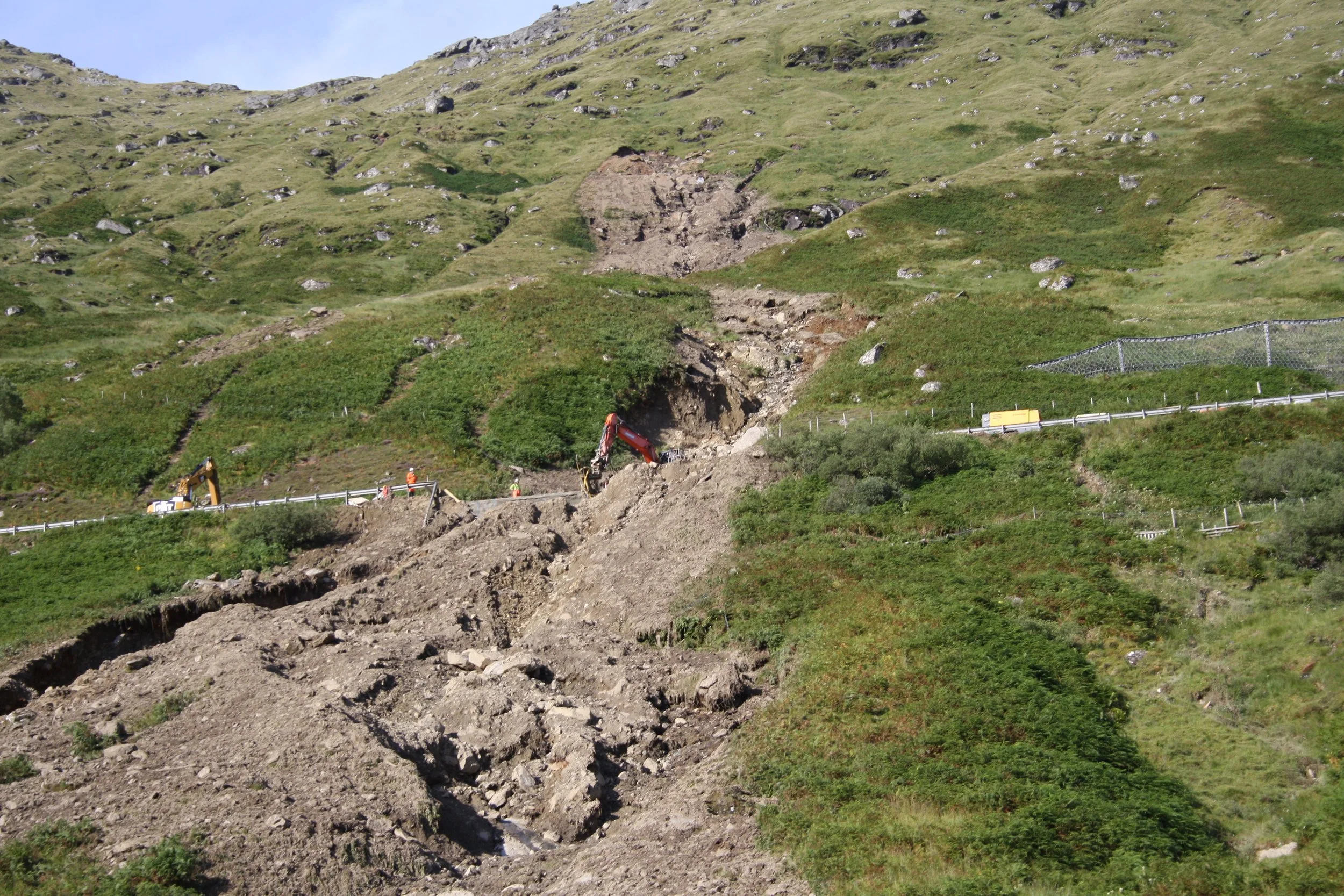Conservation charity slates Rest and Be Thankful proposal
In a written submission to Transport for Scotland, the conservation charity The Friends of Loch Lomond and The Trossachs, has listed 26 reasons why Transport for Scotland’s preferred solution to the Rest and Be Thankful debris flow problem is wrong.
The charity’s new chairman, John Urquhart, said,
“Having completely failed to grasp the importance of the cultural and scenic value of this iconic location, Transport for Scotland (TfS) is well behind the curve on this one. ‘The Rest’ is one of Scotland’s finest and most travelled mountain passes and solving the A83 debris flow problem there should have been grasped as a golden opportunity to create a world class “Gateway” experience for travellers journeying through the magnificent mountain scenery of the Arrochar Alps. Instead, TfS has gone for the comfort blanket approach of sticking to the existing road alignment which is to be protected by an ugly shelter comprising a concrete wall and roof, from which excavators will clear avalanche debris collected in pits dug behind the wall.
“As with the similarly troubled A82 upgrade, it seems the engineers have just been left to get on with it. Without proper oversight, it is hardly surprising they have come up with an unimaginative scheme which delivers the worst of all outcomes. Not only will the concrete tunnel be unsightly and noisy, in the long run it is likely to fail. Any geomorphologist would point out that “Managed Retreat” is the most sustainable way forward when faced with powerful geomorphic forces on the scale we see on the steep slopes above the road where thousands of tonnes of unconsolidated glacial debris lie poised ready for lubrication by the next extreme rainfall event.
“It is difficult to comprehend how such a short sighted and damaging scheme could ever have been selected and we wonder if the process was perhaps driven by politicians looking for a populist headline rather than a balanced consideration of all the evidence. Both the A82 and A83 schemes are being promoted as being the cheapest and quickest, but we have seen that kind of claim before in relation to ferries. The reality is that neither of them make much sense”
The full text of the Friends’ submission follows:
Transport for Scotland
Alternative proposals for The A83 approach to the Rest And Be Thankful Pass
A response on behalf of the Friends of Loch Lomond and The Trossachs
Established over 40 years ago, The Friends of Loch Lomond and The Trossachs is an independent charity which endeavours to promote and preserve the special qualities of the Loch Lomond and The Trossachs National Park.
As the preferred concrete shelter and catch pit idea has so many disadvantages and problems, we find the best option to be the viaduct or the viaduct and short tunnel.
Arguments against the concrete shelter and catch pit option
It would be unsightly and spoil a famous, historic and iconic location of outstanding scenic value
Internal sound reverberation will make the journey over “The Rest” an unpleasantly noisy experience for travellers
The traveller’s view of Glen Croe from the road will be spoiled
Clearing the catch pits of debris will be costly and will interfere with the free flow of traffic
Disposal of debris gathered from the catch pits will be expensive and damaging to the environment
The shelter and catch pits and their access track will be expensive and time consuming to construct
The shelter will limit use of the road for transporting unusually wide or high loads associated with wind turbines for example
Construction is likely to be held up by the threat of or actual debris flow events during periods of extreme rainfall whose frequency and impact is expected to increase in the coming years
The shelter itself will be vulnerable in the case of potentially very large debris flow events triggered by the expected occurrence of increasingly extreme rainfall events driven by the warming of the atmosphere
Widening the old military road (OMR) so that it can act as a relief road will cause delay and extra expense
As the hairpins on the OMR will not be widened, there will still be traffic delays during the construction period
An opportunity to return the entire southern slopes of Beinn Luibhean to nature will be lost
The catch pits will interrupt the normal downstream movement of debris fundamental to the maintenance of stream channel geometry equilibrium downstream. Watercourses starved of their normal debris load can be subject to channel margin scour which long term will lead to problems further downstream
Foundation conditions on the steep hillside required to support the shelter wall and roof may be challenging, especially given the area’s known instability
The design seems to take no account of cyclists or walkers
Arguments in favour of the viaduct or viaduct and short tunnel option
As with the case of the somewhat analogous Pass of Killiecrankie, where 40 years ago an entirely new road was constructed, travellers will have exceptional views of the glen and its surrounding mountains. Travelled in either direction, it will provide a memorable, even iconic, “Gateway Experience” commensurate with the scenic and historic qualities of one of Scotland’s finest and most travelled mountain passes
Tried and tested engineering techniques will be used
Disturbance to the environment and scenery will be minimal
A well designed and gracefully proportioned viaduct will enhance the landscape
Disruption to traffic during construction minimised
Construction can begin almost immediately
No need for a relief road during construction
Reduced traffic noise at The Rest and Be Thankful car park
With the short tunnel option, space will be available for enlargement of the Rest and Be Thankful car park and viewpoint with opportunity to provide a high quality “Gateway experience” for the visitor, including provision of motor home bays, toilets and interpretation.
The entire southern slopes of Beinn Luibhean could properly be returned to nature
There would no longer be any need for hugely expensive, risky and quite likely ultimately futile management or mitigation of the normal downslope movement of debris which we all know is being accelerated by increasingly frequent extreme rainfall events driven by global warming
Debris flow and gullying processes would be free to move material downslope where it would be deposited harmlessly in natural alluviual fans which would enhance both scenic and biological diversity
Apart from the short tunnel, most of the engineering will be on the relatively flat floor of the glen where foundation conditions would presumably be more conducive than those on the steep and unstable slopes above
A largely unaltered OMR would remain available to be re-purposed as a cycling and walking route.
While the long tunnel option clearly has many advantages and delivers on some of the points we have raised above, we do not support it because of the loss of views of the mountain scenery.
We have discounted the option of a new road through the conifer plantations on the south side of the glen as, particularly below the steep slopes of The Brack, it might end up suffering from similar problems to those which beset the existing road. Also this option does not confer the visitor experience benefits of our preferred solution and would mean the loss of large areas of conifer plantations, valuable for timber production as well as carbon sequestration and active recreation purposes.
July 2023
John Urquhart
Chair
The Friends of Loch Lomond and The Trossachs



